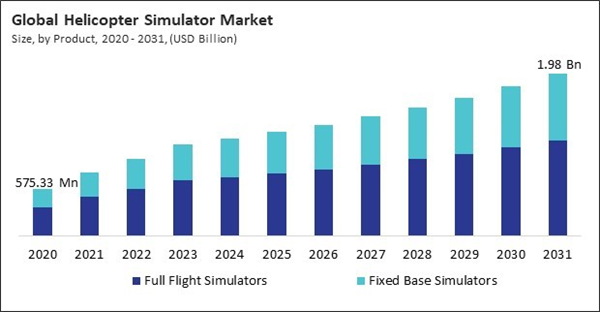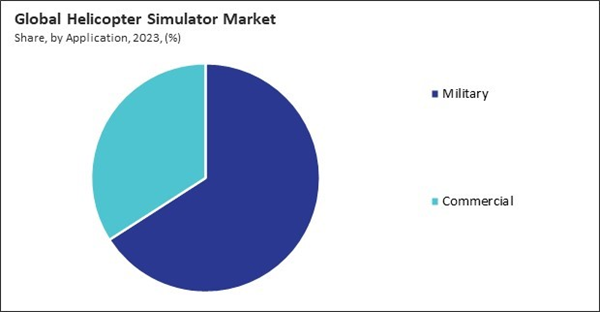The Global Helicopter Simulator Market size is expected to reach $1.98 billion by 2031, rising at a market growth of 7.6% CAGR during the forecast period.
The presence of major aerospace and defense companies, advanced military training programs, and a high demand for pilot training solutions drive the region's dominance. North America invests significantly in military aviation training, particularly in the United States, including helicopter simulation for combat and tactical operations. Thus, the North America segment recorded 37% revenue share in the market in 2023. Additionally, the increasing use of helicopter simulators in commercial sectors such as emergency medical services (EMS), law enforcement, and offshore transportation further supports market growth in the region.
The global helicopter fleet is expanding rapidly due to increasing demand from sectors such as emergency medical services (EMS), law enforcement, defense, and offshore operations. Helicopters play a crucial role in rescue missions, military reconnaissance, and cargo transport in remote areas, leading to a surge in operational needs. In conclusion, as helicopter operations continue to rise, the demand for advanced pilot training solutions, including simulators, is expected to grow.
Additionally, Governments, defense organizations, and private aviation companies increasingly invest in simulation-based training to improve pilot proficiency and operational safety. Traditional flight training using actual helicopters is expensive due to fuel costs, maintenance, and the risks associated with in-air training exercises. In conclusion, the increasing investments in simulation-based training infrastructure propels the market's growth.
However, developing and maintaining high-fidelity helicopter simulators involves significant capital investment. Advanced simulators require sophisticated technologies such as motion platforms, high-resolution visual displays, and AI-driven flight algorithms to replicate real-world conditions accurately. These features increase the overall cost of procurement, making it challenging for smaller training centers and aviation schools to invest in such systems. Therefore, high initial investment and maintenance costs associated with advanced helicopter simulators impede the market's growth.
The presence of major aerospace and defense companies, advanced military training programs, and a high demand for pilot training solutions drive the region's dominance. North America invests significantly in military aviation training, particularly in the United States, including helicopter simulation for combat and tactical operations. Thus, the North America segment recorded 37% revenue share in the market in 2023. Additionally, the increasing use of helicopter simulators in commercial sectors such as emergency medical services (EMS), law enforcement, and offshore transportation further supports market growth in the region.
The global helicopter fleet is expanding rapidly due to increasing demand from sectors such as emergency medical services (EMS), law enforcement, defense, and offshore operations. Helicopters play a crucial role in rescue missions, military reconnaissance, and cargo transport in remote areas, leading to a surge in operational needs. In conclusion, as helicopter operations continue to rise, the demand for advanced pilot training solutions, including simulators, is expected to grow.
Additionally, Governments, defense organizations, and private aviation companies increasingly invest in simulation-based training to improve pilot proficiency and operational safety. Traditional flight training using actual helicopters is expensive due to fuel costs, maintenance, and the risks associated with in-air training exercises. In conclusion, the increasing investments in simulation-based training infrastructure propels the market's growth.
However, developing and maintaining high-fidelity helicopter simulators involves significant capital investment. Advanced simulators require sophisticated technologies such as motion platforms, high-resolution visual displays, and AI-driven flight algorithms to replicate real-world conditions accurately. These features increase the overall cost of procurement, making it challenging for smaller training centers and aviation schools to invest in such systems. Therefore, high initial investment and maintenance costs associated with advanced helicopter simulators impede the market's growth.
Driving and Restraining Factors
Drivers
- Rising Demand for Pilot Training Due to Increasing Helicopter Fleet
- Increasing Investments in Simulation-Based Training Infrastructure
- Expansion of the Aviation Industry Worldwide
Restraints
- High Initial Investment and Maintenance Costs Associated with Advanced Helicopter Simulators
- Risk of Cybersecurity Threats and Data Breaches in Cloud-Based Simulation Systems
Opportunities
- Stringent Aviation Safety Regulations and Compliance Requirements
- Growth in Offshore Oil & Gas and Wind Energy Operations
Challenges
- Shortage of Skilled Personnel to Operate, Maintain, and Upgrade High-Fidelity Helicopter Simulators
- Challenges in Replicating Real-World Helicopter Flight Conditions with High Accuracy
Application Outlook
On the basis of application, the market is classified into military and commercial. The military segment acquired a 66% revenue share in the market in 2023. Military forces worldwide utilize helicopter simulators for pilot training, mission planning, and combat readiness. These simulators provide realistic training environments that help pilots practice emergency procedures, tactical maneuvers, and operational scenarios without the risks and costs associated with live flight training.Product Outlook
Based on product, the market is characterized into full flight simulators and fixed base simulators. The fixed base simulators segment procured 40% revenue share in the market in 2023. These simulators offer cost-effective training solutions, focusing on procedural and technical skill development without needing motion systems. Fixed base simulators are commonly used for initial pilot training, cockpit familiarization, and flight procedure practice.Regional Outlook
Region-wise, the market is analyzed across North America, Europe, Asia Pacific, and LAMEA. The Europe segment witnessed 33% revenue share in the market in 2023. European nations prioritize advanced pilot training for both military and commercial applications, contributing to the rising adoption of helicopter simulators. The region's strong aerospace industry, increasing defense expenditures, and technological advancements in flight simulation have driven market expansion.List of Key Companies Profiled
- Thales Group S.A.
- TRU Simulation + Training Inc.
- Frasca International, Inc.
- Airbus SE
- Reiser Simulation and Training GmbH
- CAE Inc.
- FLYIT Simulators, Inc.
- iSim Limited
- Moog Inc.
- L3Harris Technologies, Inc.
Market Report Segmentation
By Product
- Full Flight Simulators
- Fixed Base Simulators
By Application
- Military
- Commercial
By Geography
- North America
- US
- Canada
- Mexico
- Rest of North America
- Europe
- Germany
- UK
- France
- Russia
- Spain
- Italy
- Rest of Europe
- Asia Pacific
- China
- Japan
- India
- South Korea
- Australia
- Malaysia
- Rest of Asia Pacific
- LAMEA
- Brazil
- Argentina
- UAE
- Saudi Arabia
- South Africa
- Nigeria
- Rest of LAMEA
Table of Contents
Chapter 1. Market Scope & Methodology
Chapter 2. Market at a Glance
Chapter 3. Market Overview
Chapter 4. Global Helicopter Simulator Market by Product
Chapter 5. Global Helicopter Simulator Market by Application
Chapter 6. Global Helicopter Simulator Market by Region
Chapter 7. Company Profiles
Companies Mentioned
- Thales Group S.A.
- TRU Simulation + Training Inc.
- Frasca International, Inc.
- Airbus SE
- Reiser Simulation and Training GmbH
- CAE Inc.
- FLYIT Simulators, Inc.
- iSim Limited
- Moog Inc.
- L3Harris Technologies, Inc.
Methodology

LOADING...










